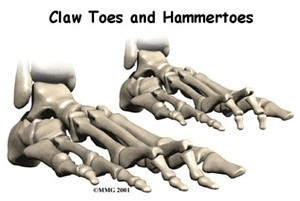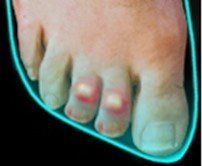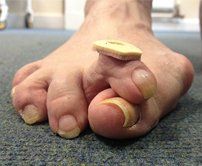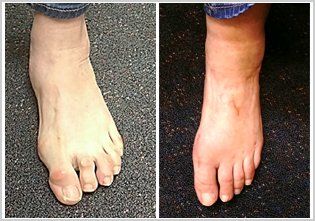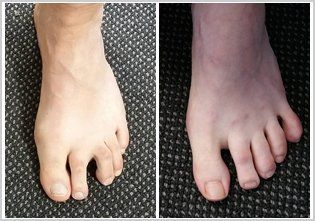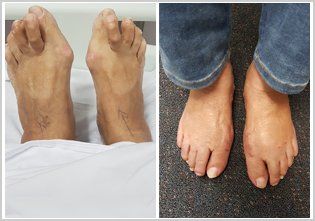Hammertoe
What Is Hammertoe?
Hammertoe is a contracture (bending) of one or both joints of the second, third, fourth, or fifth (little) toes. This abnormal bending can put pressure on the toe when wearing shoes, causing problems to develop.
Hammertoes usually start out as mild deformities and get progressively worse over time. In the earlier stages, hammertoes are flexible and the symptoms can often be managed with non-invasive measures. But if left untreated, hammertoes can become more rigid and will not respond to non-surgical treatment.
Because of the progressive nature of hammertoes, they should receive early attention. Hammertoes never get better without intervention.
Causes
There are many different causes but commonly it is due to shoes or the way in which the foot works (functions) during walking. If the foot is too mobile and / or the tendons that control toe movement are overactive, this causes increased pull on the toes which may result in deformity.
In some instances, trauma (either direct injury or overuse from walking or sport) can predispose to hammertoes. Patients who have other conditions such as diabetes, rheumatoid arthritis and neuromuscular conditions are more likely to develop hammertoes.
Are women more likely to get the problem?
It is more common in women as they tend to wear tighter, narrower shoes with increased heel height. These shoes place a lot of pressure onto the joint and predispose to deformity. It is common for patients to wear shoes that are too small and this can predispose to the problem. In a study, 95% of patients were in the wrong size shoes.
Symptoms
Common symptoms of hammertoes include:
- Pain or irritation of the affected toe when wearing shoes
- Corns and calluses (a build-up of skin) on the toe, between two toes, or on the ball of the foot. Corns are caused by constant friction against the shoe. They may be soft or hard, depending upon their location
- Inflammation, redness, or a burning sensation
- Contracture of the toe
- In more severe cases of hammertoe, open sores may form
Diagnosis
Although hammertoes are readily apparent, to arrive at a diagnosis we will obtain a thorough history of your symptoms and examine your foot. During the physical examination, we may attempt to reproduce your symptoms by manipulating your foot and will study the contractures of the toes. In addition, we may take x-rays to determine the degree of the deformities and assess any changes that may have occurred.
Hammertoes are progressive – they don’t go away by themselves and usually they will get worse over time. However, not all cases are alike – some hammertoes progress more rapidly than others. Once we have evaluated your hammertoes, a treatment plan can be developed that is suited to your needs.
Non-surgical Treatment
There are a variety of treatment options for hammertoe. The treatment the clinicians at CPSM selects will depend upon the severity of your hammertoe and other factors.
Several non-surgical measures can be undertaken:
- Padding corns and calluses. Your podiatrist can provide or prescribe pads designed to shield corns from irritation. If you want to try over-the-counter pads, avoid the medicated types. Medicated pads are generally not recommended because they may contain a small amount of acid that can be harmful. Consult your podiatrist about this option
- Changes in shoe wear. Avoid shoes with pointed toes, shoes that are too short, or shoes with high heels – conditions that can force your toe against the front of the shoe. Instead, choose comfortable shoes with a deep, roomy toe box and heels no higher than two inches
- Orthotic devices. A custom orthotic device placed in your shoe may help control the muscle/tendon imbalance
- Injection therapy. Corticosteroid injections are sometimes used to ease pain and inflammation caused by hammertoe
- Medications. Oral non-steroidal anti-inflammatory drugs (NSAIDs), such as ibuprofen, may be recommended to reduce pain and inflammation
- Splinting/strapping. Splints or small straps may be applied by the surgeon to realign the bent toe
When Is Surgery Needed?
In some cases, usually when the hammertoe has become more rigid and painful, or when an open sore has developed, surgery is needed.
Often patients with hammertoe have bunions or other foot deformities corrected at the same time. In selecting the procedure or combination of procedures for your case, the clinicians at CPSM will take into consideration the extent of your deformity, the number of toes involved, your age, your activity level, and other factors. The length of the recovery period will vary, depending on the procedure or procedures performed.
Dr Bozic prefers using minimally invasive techniques for hammer toe surgery rather than fusing (freezing) toes with pins and screws. This approach has been very successful in reducing operative trauma, post-operative pain and length of recovery.
Hammer Toe - Before and After
For Patients
First Visit Guide Price & Payments Social MediaQuick Enquiry
Thank you for contacting us. We will get back to you as soon as possible.
Oops, there was an error sending your message. Please try again later.
Consulting Location
Practice Hours
- Mon - Fri
- -
- Saturday
- -
- Sunday
- Closed

